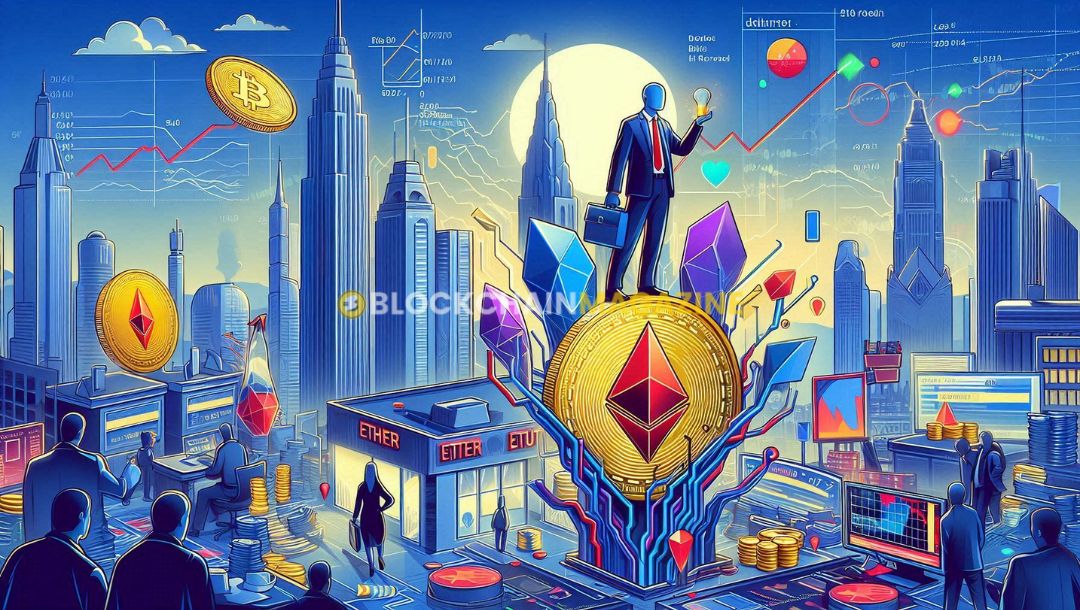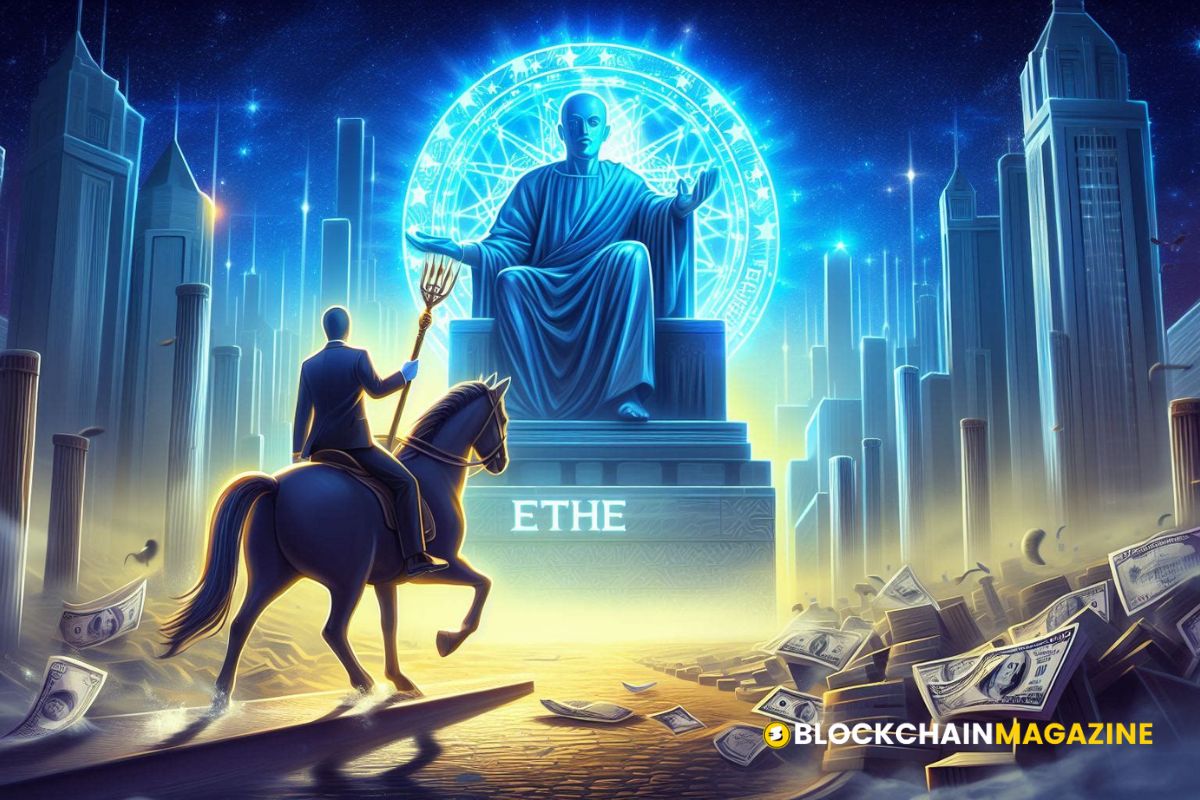Are Ether Options More Attractive Than Futures With Increased Institutional Interest: Analyzing the intriguing the risk/reward profiles in 2024
As we step into 2024, the landscape of cryptocurrency investments is undergoing significant transformations, with institutional interest in Ether (ETH) reaching unprecedented levels. This article delves into the comparative allure of Ether options versus futures, analyzing their respective risk/reward profiles in the context of heightened institutional engagement.
Key Takeaways
- Institutional interest in Ether is surging in 2024, driven by factors such as technological advancements and regulatory clarity.
- Ether options present unique risk and reward profiles, offering potential high returns but also significant risks.
- Ether futures provide a different set of advantages and challenges, appealing to a specific segment of institutional investors.
- Market speculations around Ether ETFs have a profound impact on price movements and investor sentiment.
- The growth of decentralized finance (DeFi) continues to play a crucial role in Ether’s market dynamics, influencing both options and futures trading.
Institutional Interest in Ether: A 2024 Perspective
Factors Driving Institutional Interest
Institutional interest in Ether has surged in 2024, driven by several key factors. The approval of spot Ether Exchange-Traded Funds (ETFs) by the SEC has been a significant catalyst. This regulatory green light has opened the doors for more institutional investors to enter the market, seeking regulated and secure investment vehicles. Additionally, the growing adoption of decentralized finance (DeFi) platforms and non-fungible tokens (NFTs) has highlighted Ether’s utility and potential for long-term growth.
Impact on Ether’s Market Dynamics
The influx of institutional capital has had a profound impact on Ether’s market dynamics. Record trading volumes have been reported on major exchanges like the Chicago Mercantile Exchange, indicating heightened activity and interest. This increased participation has also led to greater price stability and liquidity, making Ether a more attractive asset for large-scale investors. Moreover, the potential 60% rally in ETH as investor interest peaks for ETF approval has further fueled market optimism.
Comparative Analysis with Bitcoin
When comparing Ether to Bitcoin, several distinctions become apparent. Traders favor ETH over Bitcoin, anticipating price volatility and potential higher returns. While Bitcoin remains the dominant cryptocurrency, Ether’s unique position as the backbone of DeFi and its broader range of applications give it a competitive edge. Institutional investors are increasingly recognizing these advantages, leading to a more diversified investment approach that includes both Ether and Bitcoin.
The approval of Ether ETFs marks a pivotal moment in the cryptocurrency market, signaling a new era of institutional participation and confidence in digital assets.
Risk and Reward Profiles of Ether Options
Understanding Ether Options
Ether options provide investors with the ability to negotiate a price target, an expiration date, and a premium. This flexibility makes them attractive to a wide variety of investors, including speculators and professional traders. For investors who are long stocks, anxious options are called “put options,” while greedy options are called “call options.”
Risk Factors in Ether Options
Investing in Ether options involves several risk factors. One of the primary risks is the potential loss of the premium paid if the option expires worthless. Additionally, the volatility of Ether’s price can lead to significant fluctuations in the value of the options. Staking ether.fi involves locking up a certain amount of Ether (ETH) in a wallet to support the network’s operations, which can also introduce risks.
Potential Rewards and Profitability
Despite the risks, Ether options offer substantial potential rewards. Investors can benefit from price movements without having to own the underlying asset. This can lead to high profitability, especially in a volatile market. The ability to leverage positions and the relatively lower initial investment compared to buying the asset outright are significant advantages.
The risk/reward profile of Ether options is intriguing, offering both high potential returns and significant risks. Investors must carefully consider their strategies and risk tolerance before diving into this market.
Ether Futures: Analyzing the Appeal
Mechanics of Ether Futures
Ether futures allow investors to speculate on the future price of Ethereum without having to directly purchase the cryptocurrency. This provides a convenient vehicle for mainstream investors to gain pure exposure to Ethereum’s price movements. Until spot Ethereum ETFs trade in the US, the currently available futures-based funds provide helpful gateways into this rapidly evolving asset class. However, they come with their own unique risk factors that need to be evaluated.
Risk Factors in Ether Futures
Investing in Ether futures involves several risks. The most prominent risk is the volatility of Ethereum’s price, which can lead to significant losses. Additionally, futures contracts have expiration dates, which means investors need to manage rollovers to maintain their positions. The precarious intersection of finance and software in the crypto space adds another layer of uncertainty.
Comparative Profitability
When comparing the profitability of Ether futures to other investment vehicles, it’s essential to consider both the potential rewards and the associated risks. While Ether futures can offer substantial returns, they also require a higher risk tolerance. The amalgamation of traditional financial structures with cryptocurrency domains offers diverse investment strategies and risk mitigation, especially for institutional and risk-averse investors.
The launch of Ethereum futures ETFs caps a landmark year for cryptocurrency in terms of institutional interest and market evolution.
Market Reactions to Ether ETF Speculations
Recent Price Movements
Ether prices rallied past $3,500 on May 20, 2024, as speculation about the SEC’s potential approval of spot-based Ether ETFs fueled gains. This marked the highest price since early April, showcasing the market’s positive sentiment towards the anticipated regulatory green light.
Analyst Predictions
Analysts anticipate that assets under management in Ethereum ETFs will steadily grow over time. They believe that more institutional investors will seek regulated exposure to Ether’s price appreciation potential. The SEC approval process for a spot Bitcoin ETF took nearly a decade, but with key lessons learned, the timeline for a spot Ethereum ETF may be expedited significantly.
Impact on Institutional Investments
The SEC’s approval of spot Ether ETFs on May 23, 2024, was a significant milestone. Although trading won’t start immediately, this decision is expected to provide a convenient vehicle for mainstream investors to gain pure exposure to Ethereum’s price movements. Experts remain bullish on the long-term growth prospects for Ethereum ETFs due to rising interest and awareness around Ethereum and its game-changing technology.
The SEC’s potential approval of spot ETFs for Ether could lead to a price surge and launch in July or August.
The Role of DeFi in Ether’s Growth
Decentralized finance (DeFi) has experienced massive growth on Ethereum over the last two years. DeFi refers to financial applications built on blockchain networks that eliminate intermediaries like banks or brokerages. Everything from lending, borrowing, derivatives trading, and insurance can be replicated in a decentralized manner on platforms like Ethereum. Over $100 billion in total value locked in DeFi protocols, up from just $1 billion in 2020. DeFi users have surpassed 3 million in 2022 compared to 30,000 two years ago. Popular DeFi apps like Uniswap and Aave routinely see over $1 billion in daily transaction volume. This meteoric rise has been enabled by the programmability and containerized smart contracts made possible by Ethereum.
Institutional interest in Ethereum and the ETH token has been growing compared to other altcoins. Major financial institutions are showing greater interest in Ethereum, driven by the success of its most popular DeFi protocols. Nearly all DeFi and NFT activity occurs on the Ethereum network today, with Ether serving as the native currency. This institutional interest is a major catalyst driving mainstream crypto adoption. For investors, DeFi expands the investable landscape far beyond just holding or trading tokens. Yield farming, liquidity pools, crypto lending, algorithmic stablecoins, and more offer new ways to generate returns.
Evaluating the top DeFi protocols driving Ethereum’s growth is essential for understanding its future prospects. As regulated crypto investing gains mainstream traction, expect the options and assets invested to multiply in the years ahead. The programmability and containerized smart contracts made possible by Ethereum will continue to be a major catalyst for DeFi’s growth. DeFi is a major catalyst driving mainstream crypto adoption. For investors, DeFi expands the investable landscape far beyond just holding or trading tokens. Yield farming, liquidity pools, crypto lending, algorithmic stablecoins, and more offer new ways to generate returns.
Comparing Ether Options and Futures
Risk Comparison
When comparing the risk profiles of Ether options and futures, it’s essential to understand the inherent differences. Ether options provide the right, but not the obligation, to buy or sell Ether at a predetermined price, which can limit potential losses to the premium paid. In contrast, Ether futures require the holder to buy or sell Ether at a set date and price, exposing them to potentially unlimited losses if the market moves unfavorably. This makes futures inherently riskier, especially in a volatile market.
Reward Potential
The reward potential for both Ether options and futures can be substantial, but they differ in structure. Options traders can benefit from significant price movements with limited downside risk, as they can choose not to exercise the option if the market moves against them. On the other hand, futures traders can capitalize on both upward and downward price movements, but this comes with higher risk. Notably, the trading volume of Ethereum options reached a record $20 billion in January, indicating strong market interest and potential profitability.
Institutional Preferences
Institutional investors have shown increased interest in both Ether options and futures, but their preferences can vary based on risk tolerance and investment strategy. Ether futures open interest reached a record high in May as ETH remains bullish above $3700, reflecting a strong institutional appetite for futures. However, options are also gaining traction due to their flexibility and risk management benefits. The launch of nine Ethereum futures ETFs on the Chicago Board Options Exchange (CBOE) further underscores the growing institutional interest in these financial instruments.
The choice between Ether options and futures ultimately depends on the investor’s risk appetite and market outlook. While options offer a safer bet with limited downside, futures provide a more aggressive approach with potentially higher rewards.
Technical Analysis of Ether’s Price Movements
Ether prices have climbed over 90% since mid-October and have encountered resistance near the $3,000 price level. Analysts singled out key support and resistance levels that could dictate future price movements. The intriguing Ethereum ETF approval by SEC could attract new investors, stabilize market dynamics, and potentially push Ether prices higher.
The return of risk demand in traditional financial markets pushed the rate above $50K, which attracted new buyers and quickly took the price to $51K. On the data analysis side, we get a strong bullish signal in the form of a pullback from the 200-day moving average and recovery of the RSI from an oversold area on the daily charts. Ether has had a more challenging time and has been lagging the crypto market for the past few days, struggling to cling to $4100. Signs of a local reversal to growth are becoming evident.
What’s next for Ether prices after today’s impressive gains? Several technical analysts highlight key levels of support and resistance. For Ether, relatively measured volatility could continue up to the level of the 200-day moving average (just above 3300), which coincides with the area of extended consolidation in August and September and the start of the latest rally in October. Analysts predict Ether price movements based on technical indicators and the regulatory landscape. Potential impact on the crypto sector remains significant.
Dive into our in-depth technical analysis of Ether’s price movements and discover the factors driving its market trends. Stay informed and make smarter investment decisions by visiting our website for the latest updates and expert insights.
Conclusion
As we move further into 2024, the landscape for Ether options and futures continues to evolve, driven by increasing institutional interest and the broader acceptance of cryptocurrency as a legitimate asset class. The recent sharp gains in Ether prices, fueled by speculation around spot ETF approvals, highlight the growing confidence in Ethereum’s long-term potential. While both options and futures offer unique risk/reward profiles, the choice between them will largely depend on individual investment strategies and risk tolerance. The institutionalization of crypto is accelerating, and with it, the tools available for investors to gain exposure to Ethereum are becoming more sophisticated. Whether through options, futures, or the anticipated spot ETFs, the future looks promising for those willing to navigate the complexities of this dynamic market.
Frequently Asked Questions
What factors are driving institutional interest in Ether in 2024?
Institutional interest in Ether is driven by factors such as its growing adoption in decentralized finance (DeFi), the potential approval of spot-based Ether ETFs, and its comparative advantages over Bitcoin in certain use cases.
How do Ether options differ from Ether futures?
Ether options provide the right but not the obligation to buy or sell Ether at a predetermined price, offering more flexibility. Ether futures, on the other hand, are contractual obligations to buy or sell Ether at a future date, which can be riskier but also potentially more profitable.
What are the key risk factors associated with Ether options?
Key risk factors include market volatility, the complexity of options trading, and the potential for significant losses if the market moves against the option holder.
Why might Ether futures be appealing to investors?
Ether futures might appeal to investors due to their potential for high returns, the ability to hedge against price movements, and the structured nature of futures contracts which can provide a clear investment timeline.
How has speculation around Ether ETFs impacted its market price recently?
Speculation around the approval of spot-based Ether ETFs has led to significant price rallies, as seen with Ether prices surpassing $3,500 amid such speculation in May 2024.
What role does DeFi play in the growth of Ether?
DeFi plays a crucial role in Ether’s growth by providing a wide range of financial services built on the Ethereum blockchain, which attracts both retail and institutional investors seeking decentralized financial solutions.
Stay informed with daily updates from Blockchain Magazine on Google News. Click here to follow us and mark as favorite: [Blockchain Magazine on Google News].
Get Blockchain Insights In Inbox
Stay ahead of the curve with expert analysis and market updates.
latest from tech
Disclaimer: Any post shared by a third-party agency are sponsored and Blockchain Magazine has no views on any such posts. The views and opinions expressed in this post are those of the clients and do not necessarily reflect the official policy or position of Blockchain Magazine. The information provided in this post is for informational purposes only and should not be considered as financial, investment, or professional advice. Blockchain Magazine does not endorse or promote any specific products, services, or companies mentioned in this posts. Readers are encouraged to conduct their own research and consult with a qualified professional before making any financial decisions. The featured image used is just a creative depiction of the title and it does not intend to hurt sentiments of any person or institution. If it hurts anyone sentiments, please do not hesitate to reach out to Blockchain Magazine.

 Bitcoin
Bitcoin  Ethereum
Ethereum  XRP
XRP  Tether
Tether  Solana
Solana  USDC
USDC  Dogecoin
Dogecoin  Cardano
Cardano  Lido Staked Ether
Lido Staked Ether  TRON
TRON  Chainlink
Chainlink  Avalanche
Avalanche  Wrapped Bitcoin
Wrapped Bitcoin  Wrapped stETH
Wrapped stETH  Toncoin
Toncoin  Stellar
Stellar  Hedera
Hedera  Sui
Sui  Shiba Inu
Shiba Inu  WETH
WETH  Polkadot
Polkadot  LEO Token
LEO Token  Litecoin
Litecoin  Bitcoin Cash
Bitcoin Cash  Bitget Token
Bitget Token  Hyperliquid
Hyperliquid  USDS
USDS  Uniswap
Uniswap  Wrapped eETH
Wrapped eETH  Official Trump
Official Trump  Ethena USDe
Ethena USDe  Pepe
Pepe  NEAR Protocol
NEAR Protocol  Aave
Aave  MANTRA
MANTRA  Aptos
Aptos  Internet Computer
Internet Computer  Ondo
Ondo  WhiteBIT Coin
WhiteBIT Coin  Monero
Monero  Ethereum Classic
Ethereum Classic  Mantle
Mantle  Cronos
Cronos  Bittensor
Bittensor  POL (ex-MATIC)
POL (ex-MATIC)  Dai
Dai  OKB
OKB 




